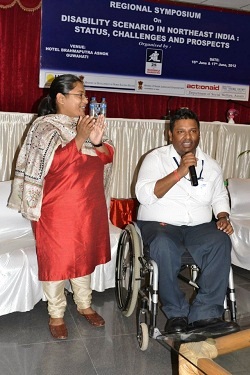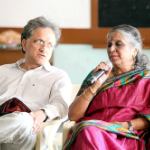Ruma Nguri, Junior Engineer, Power Grid Corporation of India Limited, Shillong
For decades we have been asking the same question and I think almost everyone here feels that we are of course alienated in some or other way from mainland India. We have read Geography and know different states and capitals of mainland India, but many people do not know about this part of the country (North-East). Are they ignorant or they do not want to actually know/accept this part of the country for we look different from them? Well! I woudn't mind if a rickshaw wala does not know where Arunachal is, but I definitely won't accept this from a school/office goer.
Sudeep Chakravarti: Let me tell you a small story, Ruma. Not too long ago, I met the Manipuri poet Memchoubi at the office of a friend in Imphal. As soon as introductions were completed, this fiery lady proceeded to slash my throat. At least it felt that way. She asked the question you have, but focused it more towards attitudes in education. They teach about the Indian subcontinent in the schools of the northeast. "How come students here" - she meant Manipur - "know about the Indian subcontinent, but students there" - she meant the so-called Indian mainland - "don't know anything about Manipur? Are they stupid?"
I sensed her obvious anger, and her equally obvious generalisation. My reply was that there is a lack of universal curiosity about what I call "elsewhere" in general and north-eastern India in particular. And certainly, that needs to be redressed. I was at the time researching my book 'Highway 39', and expressed the opinion that I wanted to write the book to address precisely this gap of information and comprehension. She didn't seem convinced, but that's another story altogether.
I shall offer a similar answer now but, of course, any discussion on this particular point should respect nuances and necessarily stay away from generalisation as much as possible.
It all begins at school, and in that, Memchoubi was spot on. I can talk about my own experience. Right through school (and I attended what is by reputation among the best boarding schools in India), we were taught nothing about north-eastern India. Nothing in history, nothing in the selection of stories in English literature texts, nothing in civics. Among Indian heroes, there was never a mention of anyone east of Kolkata. Even in geography class, the map of India was a nearly pro-forma entity: states, state capitals, climate, crop patterns, minerals and topography flowed past; the focus here was firmly limited to "mainland India". We were taught about the Gangetic plains, but the Brahmaputra was just a broad line on a map: we were taught nothing about how this great river impacts vast aspect of northeast India, and Bangladesh. At Delhi University, where I was a graduate student of history, there was not a word in any lesson, or any recommended texts, on ancient, medieval and modern India, about any aspect of north-east India.
I have seen my daughter's school textbooks. There is similar lack of mention of anything - peoples, histories, politics and places - of the northeast.
So, I think the people are not universally stupid, but a deliberately arrogant and stupid education policy contributes to making people in "mainland" India ignorant about northeast India from a child's formative years. The fact that I managed to break through such a barrier of enforced ignorance, and my daughter is doing so now, these are our personal efforts of curiosity and learning. And in this, I firmly believe that we are part of a growing tribe. This can only be to the good.
As I have said elsewhere in this ongoing conversation with readers of thethumbprintmag.com, stereotypes of northeast offered by the conversations, writing and quite paternalistic attitude of several IAS, IPS and armed force personnel posted over the years to the northeast have contributed to the blindsiding of several aspects of northeastern India in the "mainland" Indian psyche of politics and nationhood.
This clearly needs to change. Judicious and productive outrage, dissemination of information, and petitions to change the way students are taught about their own country must become the norm. Perhaps you and I and other readers of thethumbprintmag.com - and, indeed, thethumbprintmag.com itself - can perhaps energise a campaign to educate comprehensively. On another count, I am so happy that literature and culture are increasingly making people aware of the northeast. So happy that travel agents are beginning to push "northeast" tours, even though most of these only offer bits of Sikkim, Assam, Arunachal Pradesh and Meghalaya as destinations. There are other ways, and some are discussed in an earlier reply to Mr Yanpvuo Kikon's comments and query immediately preceding our conversation.
Equally, we must accept a reality, Ruma. Unfortunately many of us tend to live in silos, practice tunnel vision. No amount of positive energy in education will alter the attitude of those who choose to remain ignorant of a place, people or situation because these simply do not interest such persons. No power on earth, even Memchoubi's rightful indignation, can alter that.
Take even MC Mary Kom, arguably the best known face of the northeast in "mainland" India. Her performance at the 2012 Olympic Games would have finally imprinted the words "Manipur" on the minds of many "mainlanders", but I doubt many of her admirers would take the trouble to locate the state on a map. Tragic, but true.
That doesn't mean we should all stop trying for change, stop being ambassadors of information and better understanding. To do nothing would be equally tragic.
Yanpvuo Yanfo Kikon, Marketing Manager, NH Energy, Pune, Maharashtra
Due to the rise in migration from NE to the mainlands, racial profiling is another recent problem that the country is faced with in addition to the problems of alienation caused by geographical and historical factors. Just yesterday I faced multiple incidents where someone uttered behind our backs "Motherchod Chini Log", a grown up man yelling some gibberish like "Ching chong ching"; for a person like me who have lived in the mainlands for more than 10 years, I just laugh it off and ignore the ignorant but for the thousands of fresh young minds who come for education and work, it is demoralizing because their Indian-ness instantly flies out of their soul. When they complete their education and go back home, a new form of Alienation is injected in their minds. Do you feel that much emphasis need to be directed in the mainlands as well? What could be a practical approach to tackle this new mess?
Sudeep Chakravarti: Dear Mr Kikon (or Yanpvuo, if I may?), it is a pleasure to make your acquaintance. Thank heavens for your forthrightness and fortitude. These are perhaps the greatest tools, to my mind, for addressing precisely the issues you raise.
I am hardly a guru for integration, merely a traveller and storyteller with a passion for conflict resolution. In some ways you've asked a question that is extremely difficult to answer; and I can only try to personalise such an answer, as inadequate as it must be.
While I empathize completely with your consternation and hurt, we need to face facts about India and this sub-continent. We live in one of the most racist regions in the world on account of great lack of exposure combined with deep-rooted prejudices. You and numerous others have encountered such sick minds. Some from the northeast have recently lost their lives to such prejudice and cruelty in Delhi, Mumbai, Pune and places in southern India.
Look around you. You are not alone. (And here, for a moment please leave aside those from north-eastern India). Have you heard/ seen how an ordinary Nepali person is addressed/ treated in India? Is it any wonder there is great resentment against India in several parts of Nepal? I am furious each time I hear so-called cultured Bengalis make fun of the Assamese language because of some differences in pronunciation of similar words; or hear Bengalis dismiss those from Odisha as "Urey" or those from Bihar as "Khatua". In Assam, "Bongali" is often a term of derision. You live in Pune. You know first-hand how those from northern and southern India are these days institutionally and politically reviled in Pune and Mumbai. I live in Goa, so I know first-hand the resentment against "bhaille" or outsiders who are even blamed for vagaries in the weather! Or, ask a Mussalman who these days goes looking for accommodation in a predominantly Hindu area anywhere in India.
As I like to say, I love the idea of India, but perhaps Indians need to actually work at the idea too. As we know well, anything can trigger a reaction: insecurity about livelihood, deep-rooted bias, so many things. But I will also say this: Deeply tragic though the Richard Loitam and Dana Sangma incidents were, and deeply offensive as your personal experiences at being cursed are, it is not as if the entire state-or country-were against the youngsters or against you. They, and you, had the misfortune to run up against some very sick people with very deep insecurities.
And here, I implicitly believe, also lies the partial solution to this "new mess", as you put it.
As more Mainlanders -not armed forces sorts or bureaucrats, but non-government professionals and tourists-travel to north-eastern India, the perception they bring back is going to change the perception towards those from north-eastern India in the Mainland. This is an ongoing process, slow but welcome.
But the major boost will probably come from those who belong to the north-eastern India and travel to the Mainland for study, work or tourism. Many north-eastern communities (and as you know, specific tribes) already have very strong networks in several Indian cities and towns-especially university towns. They come to the aid of newcomers, as it were, by holding orientation meetings and generally supporting those of the community both in times of celebration and trouble.
This was seen most recently during the unpardonable backlash in Mainland India over the Bodo-Mussalman fracas in Assam. North-eastern communities came together without thought of ethnicity and histories and approached local and civic authorities as one group for protection. It worked.
I believe this should be extended as a continuous process. And also, extended beyond the interaction with authorities into interaction with local communities. People from "elsewhere", including the northeast must establish integrated, comfortable links of trust and friendship with communities where they choose to live. Please take this as well-meaning suggestion from a lifelong gypsy and traveller who has almost always lived away from his homeland. The one guarantee to acceptability (or tolerance) I have found is to link with the community I have chosen to live in/with. I practice this also in Goa, my present home, which has very strong undercurrents against the "bhaille" or "outsiders". I consider Rajasthan a second home. I am actively considering relocating for part of the year to Shillong or, possibly, Kohima. How can I ever succeed without respecting local culture and traditions and histories, and respecting local people?
Here I must recall the words of Karma Paljor, my younger colleague in media and a well-respected anchor with CNN-IBN. During an interaction about the northeast in New Delhi some months earlier, Karma, who is from Sikkim, spoke passionately (and humorously) about his student days in southern India and, later, of his professional life in Delhi. He deliberately chose to not live in closed communities with others from north-eastern India, but stayed where locals stayed. Yes, he was initially made fun of and was misunderstood, but he now speaks southern Indian languages and counts several close friends from his time in southern India -- who understand much more about people from northeast India than they ever did, in a growing relationship of mutual respect.
A Meitei family lives in the same neighbourhood as my parents, south of Kolkata, in a semi-rural area of predominantly of Bengalis, and specifically, of Mussalman Bengalis, both local and immigrant. The family is, only after a few short years, a valued and respected part of the community - neighbours visit their home for Meitei festivals, and the matriarch even teaches others Meitei cooking. When my mother passed on some years ago, they held prayers. What more can I add?
There are ways to be part of another community without losing the identity and security of one's own culture and history.
I believe north-eastern communities should actively spread the word of their own cultures and histories and dreams in a positive way in the "elsewhere" communities in which they choose to live and work. I suspect they will find over time a near-magical change in local attitudes. With more interaction and conversation comes understanding and respect - we all know that. (Take the example of South Asian migrants to the UK and US.)
I also believe that north-eastern people must pressure the media - especially government media - to get away from the ridiculous, unifocal representation of the northeast as meaning only colourful festival dresses and dancing. This sort of stereotyping is immensely damaging and reduces understanding of a people to an arrogantly basic level. Like much of north-eastern India, vast parts of Mainland India is a victim of this simplistic projection practiced by Government of India agencies. Other media still tends to perceive NE India only in terms of conflict. How about some agencies, or community groups, or actively pitching human interest stories beyond conflict (or, even, positive human interest stories arising from conflict and conflict resolution) to media. There needs to be sustained PR and those in a leadership position, or a position of socio-economic advantage could contribute to it.
And, try this: with so many NE students and workers in several core Mainland areas, I believe it is possible to raise cultural pressure groups. Next time folks visit to invite student enrolment or BPO/KPO hiring, they need to be asked some tough questions. In turn, they could be invited to visit several areas in NE to better acquaint themselves with local cultures, sensitivities and sensibilities. I strongly believe admission heads and HR heads could be swung over to this idea - even if for the cynical (but realistic) long-term goal of better revenue.
There are so many ways, some hard-edged and some others idealistic, and I have mentioned some of these in replies to some others queries at thethumbprintmag.com. You will find these at the same webpage this conversation is posted.
Let me end with just three points. One, I sincerely hope that more Mainlanders than merely the government official and desperately poor labourer visit north-eastern India. Two: I hope as sincerely that, north-eastern Indians do not look upon all Mainlanders as being perpetrators of evil against north-eastern India.
The third: I hope there is an increase in the tribe of people like you who take life on fully and completely, who deal with rudeness and unpleasantness with the calm, balance and immense maturity that you display. Bravehearts, like you.
I will do what I possibly can in my own infinitesimally small way to increase understanding and reduce degrees of conflict. And so, to shared peace and prosperity, my friend.
Ananya S Guha, Academic Administrator, Indira Gandhi National Open University, Shillong
Do you think that the basic problem in Northeast India of its people is that of alienation? If so how do we view this perspective? Also the recent violence in the Bodo areas of Assam, is it only the immigration factor that is responsible for it? How do we resolve the feeling of alienation if any?
Sudeep Chakravarti: Dr Guha, a pleasure to continue our conversation at The Thumb Print. Yes, I certainly believe that the basic problem in Northeast India in relation to Republic of India is that of alienation. The historical disconnect also became a geographic disconnect on account of Partition, when the fist of East Pakistan, as it were, emerged onto the sub-continental map, and left for India and its Northeast the slim 'chicken's neck' as a lane of communication. Undivided India, I believe, would have had less paranoia about the east than a divided India did - deeply afraid that it was about to lose more of itself to Pakistan's machinations, China and Burma's geopolitical bites, and its own administrative weaknesses.
As you know so well, legitimate issues of identity and aspiration were met with brute force by Government of India and its agencies. Additional paranoia after the war with China in 1962 merely made it worse-Mizoram and Manipur experienced such paranoid over-reaction after Nagaland. Over time, Northeast has come to be characterized in the minds of Mainlanders as a region of conflict. Equally, many people in Northeast India see only the heavy hand of India-through the army, Assam Rifles, paramilitaries, bureaucrats and police officers-not the face of the remainder of India where people simply wanted to move ahead in life with as much peace and tranquility as possible. I believe greater interaction and communication has reduced this mutual sense of distrust and alienation. Of course it's vastly present, but I sincerely believe we're finally moving from a vicious cycle to a virtuous cycle.
Moreover, I believe that, if the Government of India has the courage to apologize for its errors in the Northeast, the distrust would be greatly reduced. If Indians not long ago expected the Queen of England to apologize for Jalianwalla Bagh, then what's the problem if India's government gathers courage to offer its own apologies for gross mistakes and mistreatment of people in Northeast India, people it often threatened, tortured, raped, maimed, burnt, shot, and killed in the name of preserving the republic, preserving democracy and - perhaps the most unkind and bizarre cut - in the name of making such people its own?
In addition -and this may not be a fashionable or 'politically correct' view - I believe that if local politicians and administrators in Northeast India stopped looting their own people (specifically, social and economic development funds), feelings of alienation may subside to some extent. Mainland politicians and administrators have long ceased to be the only thieves of public funds and public trust in Northeast India. The Northeast's own are today as guilty. This thievery must continually be exposed, and the public must extract its punishment through various disclosure norms, elections, and even the judicial process. And this applies not only to Northeast India but to the entire rotten political and administrative superstructure of Republic of India.
As for the recent violence in Bodo areas, politics combines with issues of identity and migration to make it so. As I wrote some weeks ago in Mint, where I have a Friday column on issues of conflict in South Asia, and mentioned in a recent interview with The Sentinel, it is time to look hard at issues of immigration through the singular lens of reason instead of bi-focals of bigotry.
Assam has from the time of India's Partition remained a migration hot-spot. Vestiges of the political maneuvering that led to its inclusion in Republic of India instead of what was then East Pakistan (and is today Bangladesh) have remained. Indeed, ethno-religious dynamics have shaped discourse in Assam. Such discourse has spread to other areas of Northeastern India, Tripura and Meghalaya in particular, and today fuels emotion in Nagaland, Manipur and Mizoram. The issue goes beyond the realm of religion-Hinduism, Islam, Christianity, tribal beliefs-to the equally real world of migration.
To cut a long story that you are aware of short, Tripura and parts of Assam-at the time Assam included the present-day state of Meghalaya-were inundated by the influx of largely Hindu Bengali migrants from across the border in two waves: one around the time of Partition and later during the Bangladesh war in 1971. Among other things, it transformed Tripura from an overwhelmingly tribal entity into a non-tribal one. In Assam, especially southern Assam, such migration has never sat comfortably, especially as over the years it has included Mussalman migrants from other parts of India as well as present-day Bangladesh-as much the persecuted in 1971 as Hindus.
Over the years, migration caused by religious and political discord has reduced, giving way to migration for livelihood. It is a matter of record that several politicians in the North-East have wooed immigrant populations to ramp up electoral support, over the years transforming illegal migration into legal by using the Indian practice of "regularizing" an illegality by administrative and legislative fiat. Resentment accruing from such political manipulation has often exploded into chaos-the Nellie massacre in Assam in 1983 was only the more infamous of such incidents-and has spawned student movements and armed rebellions. (Going more local, trouble between Bodos and immigrant Muslims in the Bodo Territorial Council-administered districts of Kokrajhar, Chirang, Baksa and Udalguri is no longer rare phenomena.)
Those who would dismiss the issue of migration need to keep in mind that almost without exception across the Northeast, people are wary, even frankly resentful, of migration from the Indian "Mainland", let alone from Bangladesh. Forced migration caused by the 19th century colonial practice of bringing plantation workers into Assam from eastern India; and 20th century influx of traders and low-end workers that continues to the present day causes local heartburn acute enough to fuel strong rhetoric and violence.
The concern is real, and goes beyond religion. The fact is that, unless radical and rapid economic transformation characterizes India, in-country migration will remain-whether it from other parts of India to the Northeast, or the more "seasonal" variety that brings those of North-East India to the Mainland in search of jobs.
Equally, the fact is also that, until radical and rapid economic transformation characterizes Bangladesh, both Bangladesh and India will be powerless to stem this migration. Moreover, the ongoing, deeply patchy exercise to fence India's 4,000 km-plus border with Bangladesh will prove meaningless in the face of migration triggers that range from increased incidence of flooding in Bangladesh to escalating population pressures. Livelihood needs will push this. Importation of religious belief, by virtue of Bangladesh's largely Islamic construct, may be a corollary, but religion has for long stopped being the motive for migration.
India and Bangladesh can no longer live in diplomatic denial of this truth. A tense present and an uncertain future need to be urgently addressed by both countries to minimize the effects that fear and loathing regularly visit upon India's Northeast, a complex, hurting region with deep memories.
Anjana Mahanta, Freelance Social Science Researcher, Guwahati
In this period of administrative anarchy in the Northeast India, what according to you should be the strategy to counter the cumulative effect of destabilization and decay in the value system? How to reverse the disarray in the institutional mechanism?
Sudeep Chakravarti: I imagine this reply will convey what you already know, Anjana. Also, I assume you mean decay in political and civic value systems. In that case, the greatest and most effective counter must surely come from citizens; what are today called 'civil society' groups; media; and community leaders from the villages-up. Most politicians and many administrators are no longer driven to fulfil their jobs and duties unless they are compelled by public pressure and, in certain cases, by an activist-judiciary. This is as true of the Northeast as it is of 'Mainland' India. It is today a structural malaise, a deliberate infection by which the worst practices of Republic of India have passed on to political leadership and administrators of Northeast India.
Constant, focused public pressure through every available legal mechanism appears to be the one way out, backed by media (and, if such media is unwilling, corrupted as they may be by business and political interests, then by new media over the internet and internet-radio which can be integrated with mobile telephony: such an approach has begun in Chhattisgarh). I would imagine that public pressure created around tactically and strategically sound 'pressure-opportunities' such as key local and state-level elections, and rallying points such as project-reviews and information gathered through the Right to Information Act and similar public devices would also serve as levers to pressure politicians and administrators. Such networking needs to be non-partisan to be successful, or else special interest groups splinter to specific special interests rather than first working first to ensure a space in which joint platforms benefit from a joint position of strength.
I believe there must also be more platforms that showcase the importance of the Northeast and the urgency with which local and regional issues need to be addressed from a security and development perspective. I don't think enough of it is being conveyed across India to pressure policy changes. Certainly, not enough is being done globally, either in the Northeast's immediate neighbourhood, ASEAN, United Nations platforms, and such. Some efforts exist in isolated silos, but there isn't real momentum yet, real pressure.
Ultimately, there can be no recourse to reversal of deep malaise except through people themselves, and cause/opinion/community/media leaders who have the time and courage to gather pressure and forcefully - and figuratively, if not literally! - plant kicks on the backsides of those who presume to misgovern in the name of the electorate, the citizenry. Such an approach would also reduce the need for armed rebellion, which can breed its own cycle of intimidation and fear. Northeast India knows this only too well. 'Non-state armed groups' must be accountable at least to the people on whose behalf they seek to fight!
Banamallika Choudhury, Development worker
Most of the stories, incidences that have been woven into your experiences are known to people in Northeast particularly the ones who are thinking, reading, following politics. Do you feel being an outsider the stories had a novelty value to you?
Sudeep Chakravarti: I would submit, madam, that even among those whom you describe as "thinking, reading, following politics" in the Northeast, often what happens in another state in the Northeast is not always known to them. I have lost count meeting such people as you describe. Perhaps you mean: those with wider perspective and acute interest in the fields of human rights, activism, security, administration, and so on. If so, you are partially correct in your contention as even among these select few, not all have recall of incidents across the Northeast in detail except the very major ones. Even then, there are several relatively minor players involved in several of the incidents I describe whose existence is diminished in the memories of people-in certain cases they aren't even known. Indeed, in several cases, while names and incidents may be known, the faces and lives behind these incidents, the humanised versions behind dry statistics, human rights documentation and a couple of paragraphs in a news report, may not be known. That's what I attempt to bridge.
There is no question of stories having "novelty value" for me, but of the stories being relevant for the kind of accessible, easily-understood story that I wished to tell in Highway 39: Journeys through a Fractured Land, a work of narrative non-fiction aimed primarily at the reading public (in the living rooms, policymaking rooms, rooms of education), outside Northeast India-in the so-called "Mainland", even elsewhere in the world. Especially, to take them away from narratives that are usually told by retired IPS officer, retired Army officers, retired Intelligence officers, and retired Governors who were once Army or Intelligence officers.
There are certain histories, touch-points and characters relevant to any telling, and certainly relevant for my book. Equally important, some of the incidents and characters I describe in Highway 39 were part of the political, security and human rights drama being played out as I was actually in the region researching the book. The faction-fighting among Naga rebel groups; citizens' protests and reconciliation processes; the "Rabina" and "Sanjit" incidents in Imphal; the abduction of the child Vidyarani; protests by Apunba Lup and the crackdown, these were happening literally as I travelled. To describe these, and meet and talk to participants and victims of the dramatic and seminal events is a crucial part of the immediacy of the narrative. It also brings to my readers closer to the dynamics of a part of the Northeast. Besides, I keep meeting people from the Northeast who tell me things on the lines of "Thank you for telling our stories to the Mainland, to the outside world." My email and Facebook in-boxes daily receive such mail. It partly vindicates my effort and gives me strength to continue.
There are also several descriptions and interactions in Highway 39 that are not widely known to even many learned folk, which bring out the inner character and thinking of several key players in politics and the security establishment. I'm privileged that I had the opportunity to encounter these and share it all with my readers.
And here, I am reminded of an evidently callow and obtuse critic in an Imphal-based newspaper who bemoaned the fact that some incidents and characters from Manipur in Highway 39 were "well known" to those in Manipur, even the ones from 2007, 2008, 2009 and 2010-during my time of travel and research, and therefore relevant to the narrative. It is almost as if this critic wanted newer atrocities committed so that Highway 39 would measure up to her idea of newness! This critic went to the extent of criticising even those Manipuris who spoke to me, shared their lives and thoughts with me (and, therefore, with my readers), often at great risk to themselves. I guess the only cure for cynicism is an open mind and common sense!
Banamallika Choudhury: Also, there seems to a new growing fetish among certain crowd in India about the Northeast. Being here, having friends, knowing about it gives one a sense of adventure and political correctness of caring for the marginalised etc. Do you get similar feelings?
Sudeep Chakravarti: As it happens, I have intimate knowledge of several troubled areas and trodden people in India and South Asia, where I have travelled extensively, and have had the privilege of learning about such places from those who are from these places, and live and work at such places. These are ambassadors of their culture, politics, hurt, hope and aspiration. Many of them have become my friends and that is my singular honour and joy. It is not a fetish (whatever you mean by that). It is about the work I do as a writer who has deliberately chosen to engage with people and issues for 27 years-my collective CV as a media person and writer. It is not about a sense of adventure or about political correctness; it is about a choice we make. You understand: I can only speak for myself. And, by doing what I do, if I feel I am contributing even in an infinitesimal way to greater understanding, and that makes me sleep better at night, then what on earth is wrong with it?
May I suggest that it may be more productive and less cynical to discuss the effect that writing on conflict of any sort can have. For one thing, such writing exposes audiences to a particular conflict and reasons for conflict. For another, writing on conflict can also contribute to conflict resolution by increasing understanding and, hopefully, contributing to acceptance of reasons for a conflict-and, thereafter, ways of resolving that conflict. I wouldn't look at this as a "fetish". You are a development specialist, an activist in your own way. Do you pursue your calling as a "fetish"? Or is it done with the purpose of abetting awareness, aid, and solution? Please don't dismiss well-intentioned, honest work-including work like your own-in cynical generalisation.
Banamallika Choudhury: What do you see as a beginning of a resolvable end? Apart from the state, many Indians too (although they have never been here or do not know much abut it) carry a proprietorial feeling towards the Northeast. A mutual separation followed by a mature neighbourly relationship seems out of question and concepts. What do you feel?
What you say is largely true, and that is a major part of the problem: both the establishment and many even seemingly progressive Indians accept this Livingstonian construct as far as Northeast India-indeed, any part of what is declared and claimed as India-is concerned. To them, India's integrity is non-negotiable.
I hold a different view. For me India's integrity is not about being watertight with a map, a paranoid "barbarians at the gate" approach, but about India's integrity being morally sound and politically sound-as a democracy should be. India became what it is on account of a ludicrous Partition, with several princely states and ethnic groups choosing to, or not, to be part of the Indian Union. If a people wished for greater autonomy then-even independence from India-and wish for such a thing now, then it is incumbent upon India to hear them out and work out a practicable solution rather than destroying people and their legitimate dreams back to the Stone Age.
I have no problem in considering an independent Nagaland or Manipur, for instance. No map is static forever. Few thought East Timor would break from Indonesia, but it did. Eastern Africa is going through its own re-birthing. Not too long ago who gave Namibia a chance? Or thought that USSR would turn into CIS and the "Stans"? I have openly discussed the matter of such things in Northeast in Highway 39. Indeed, such thoughts are prominently displayed on the jacket of the book, where a Naga gentleman is quoted as saying: "Do you want an honest answer? I don't consider myself an Indian." In policy white papers I have written for think-tanks, I have openly considered the possibility of various options of a Naga nation; the theoretical possibility of Manipur (specifically, Imphal Valley and parts of Manipur that wish to be with such a political construct) even requesting status as a United Nations protectorate as a precursor to independence; and demographic and political changes totally transforming the present-day construct of North-East India and its internal and external boundaries.
People's aspirations and history-in-the-making are organic processes. One shouldn't have a closed mind about such things. Everyone's a patriot. We need to acknowledge another's patriotism even though it may come from a different perspective.
Dr Suravi Sarma, doctor turned writer, Hyderabad
Dr Suravi Sarma: Is the concept of perceived 'shared sovereignty' in the younger generation of Nagas good news for the Indian Government? How do you think the government should farther build up on that?
Sudeep Chakravarti: Thank you for your query, Dr Sarma. My view is that, if the Nagas, whether of the older generation or younger generation are arriving at some manner of consensus as to their future, it is first and foremost good for the Naga people. 'Shared sovereignty' is a concept that some Nagas (including some Naga "national workers") accept by virtue of a present-day reality that cannot wish away India's overwhelming proximity even if the Naga nation were to theoretically gain independence, even gain great autonomy.
It will be a mistake were India's government to take this so-called "good news" for granted. Republic of India has inflicted a terrible price on the Nagas for merely asking to be heard on the question of Naga independence-which was actually a plea for autonomy, even "shared sovereignty". Zapu Phizo's early discussions with Government of India, and a plan as proposed by Sir Akbar Hydari, all point to a reality of early conflict resolution that Government of India deliberately chose to ignore.
To take things ahead, the Government of India should have the courage to apologise to the Naga people for past wars and atrocities committed. It should work actively to convert the long-standing ceasefire agreements with various factions of National Socialist Council of Nagalim into peace deals. These will come about if Government of India and the intelligence and security establishment desist from playing games and encouraging faction fighting; and fully engage the Naga people, rebels included, about honourable rehabilitation and power-sharing. There is a great positive energy among the Naga people to formally end conflict (in this, they hold both Government of India and the Naga rebel leadership responsible) and look to a future of corruption-free, violence-free, fear-free development.
Just creating a state is not enough. Nagaland was made a state of India in 1963. It was more political farce than integration and true recognition of Naga aspiration. The government's attitude needs to change. If that happens, all other attitudes will change.
Find us on facebook: facebook.com/TheThumbPrintMag
Also read:







































